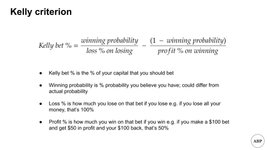
Having faith in the Kelly Criterion for angel investing

Smart VCs know they cannot reliably pick winners. Instead, they spread their bets by diversifying.
Ilya Strebulaev • The Venture Mindset: How to Make Smarter Bets and Achieve Extraordinary Growth
Fewer Losers, or More Winners?
oaktreecapital.comThe best you can do right now is to choose a portfolio with the highest geometric mean of the probability distribution of outcomes, as computed from current means, variances, and other statistics. The returns and volatility of your investments will change with time. When they do, you should adjust your portfolio accordingly, again with the sole obj
... See more